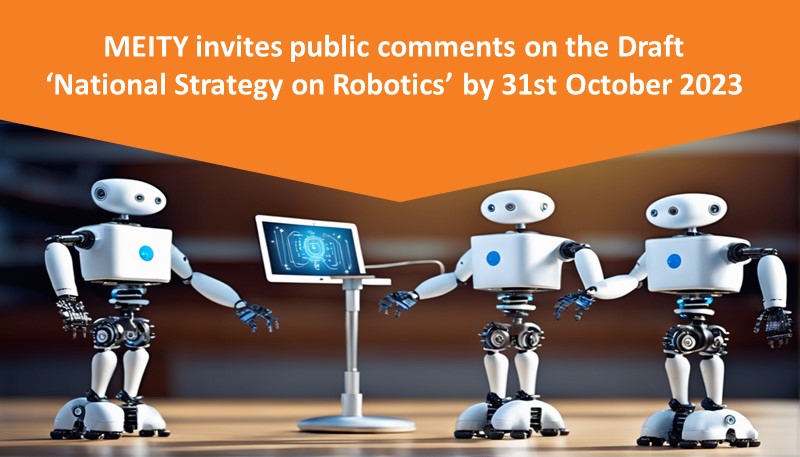The Ministry of Electronics & Information Technology (MeitY) has invited public comments on the Draft National Strategy on Robotics by 31-10-2023. The Draft ‘National Strategy for Robotics’ seeks to place India as a global robotics leader by 2030, aligning with the goal of Make in India 2.0 of enhancing India’s role in the global value chain.
Mission:
The mission of India’s National Strategy on Robotics include making India a global hub for research, design, development, and manufacturing of robotics, fostering a sustainable innovation ecosystem, enhancing competitiveness for Indian robotics companies and startups worldwide, promoting the creation of Indian IPR in robotics, and nurturing a skilled robotics workforce.
Objective:
- Position India as a global leader in robotics by 2030 in manufacturing, healthcare, agriculture, and national security sectors.
- Enhance the stability and competitiveness of domestic industries to increase value addition within the supply chain.
- Foster and improve the research and innovation ecosystem in India with targeted investments aligned with robotics priorities.
- Adopt a coherent approach to robotics research and innovation, including integration with emerging cyber-physical systems and AI technologies.
- Expand the use of robots in India by diversifying their applications and creating new domestic and international markets.
- Strengthen collaboration with global robotics centres, academic institutions, experts, and organizations.
- Establish governance mechanisms to make India a global benchmark for the performance, quality, and reliability of its robotics.
- Develop a skilled workforce by providing training and education in robotics and related fields.
Focus areas for Robotic Automation in India:
The National Strategy on Robotics in India focuses on four key sectors which has been identified based on the parameters of size, growth potential, potential for automation, maturity of robotic technology, AI penetration, and assessment which would have significant socio-economic impact as well as position India for global leadership by 2030:
Manufacturing-
Globally, the manufacturing industry is on the brink of significant technological change and relocation. However, the manufacturing sector has been pivotal to India’s growth as an economic powerhouse. Despite its promising potential, the Indian manufacturing sector still faces a few challenges which including product quality and production warehousing limitations.
The potential use cases of Robotics in the Manufacturing sector are:
- Logistics & Warehousing automation
- Shopfloor Transformation through Cobots
Healthcare-
The Indian healthcare sector is expected to reach $50 billion by 2025, with the government increasing its healthcare expenditure from 29% to 41.4% of the total expenditure between 2014-15 and 2019-20. However, the COVID-19 pandemic has exposed weaknesses within India’s healthcare sector, including the current challenges of Ageing Population and Limited Infrastructure.
The potential use cases of Robotics in Healthcare are:
- Cleaning & Disinfecting Robots
- Safety & Monitoring Robots
- Surgical Robots
Agriculture-
Agriculture is a crucial contributor to India’s economy. It is the largest employer of the Indian workforce which constituted 18.8% of the Gross Value Added (GVA) in 2021-22. The sector saw a growth of 3.6% in 2020-21 and 3.9% in 2021-22, driven by allied sectors including livestock, dairying, and fisheries. Despite such gains, the Indian sector faces a few structural and operational issues, including productivity per unit of land and occupational hazards.
The potential use cases of Robotics in Agriculture are:
- Crop scouting
- Spot spraying Robot
National Security-
The government has initiated reforms to boost self-reliance in defence manufacturing and technology. Technological prowess is essential for ensuring national security in the 21st century. The potential uses of Robotics in this sector includes mine detection UGVs, Surveillance Robots, Remotely Operated Vehicles.
Thus, the National Strategy for Robotics is a crucial part of India’s AI strategy, aimed at harnessing technology’s potential, managing risks, and establishing global recognition in robotics across key sectors.
Please refer to the hyperlink below for a detailed read.
Source : Ministry of Electronics & Information Technology





